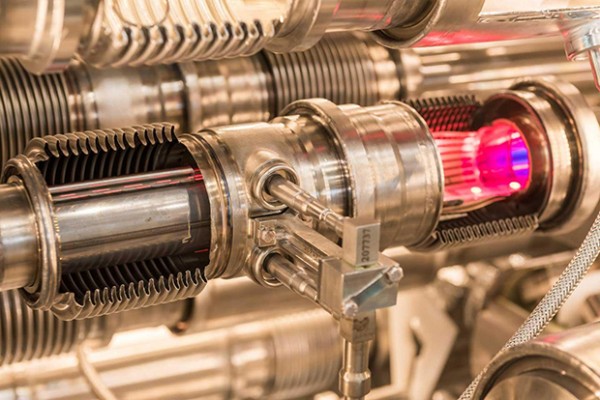Physicist Helps Discover Subatomic Particles

A pink glow illuminates the inside of this model of the LHC beam pipe, which is used to train engineers and technicians at CERN. ( Photo by Guillaume Jeanneret/CERN)
Steven Blusk, associate professor of physics, has identified particles known as Xi_b'- and Xi_b*-. Although the particles had been predicted to exist, nobody had seen them until now. The discovery is part of his ongoing work at the Large Hadron Collider beauty (LHCb) experiment at CERN in Geneva, Switzerland.
“The particles we’ve discovered are quite unique,” says Blusk, a leader in experimental high-energy particle physics. “Each one contains a beauty [b] quark, a strange [s] quark and a down [d] quark.”
A baryon is a subatomic particle made up of three quarks, bound together by strong force. Two other familiar baryons, the proton and neutron, combine with the electron to form all the known elements of the periodic table.
“The building blocks of all known things, including cars, planets, stars and people, are quarks and electrons, which are tied together by strong, electromagnetic forces,” Blusk says.
Unique to each newly discovered particle is its mass, which is approximately six times larger than that of the proton. Blusk attributes its size to the presence of a heavyweight b quark and to the particle’s angular momentum—a property known as “spin.”
In the Xi_b'- state, the spins of the two lighter quarks point in opposite directions; in the Xi_b*- state, they are aligned. The difference is what makes the Xi_b*- a little heavier.
“The Xi_b'- is close in mass to the sum of the masses of its decay products. If it had been just a little lighter, we wouldn't have seen it at all,” Blusk adds.
Much of Blusk’s work draws on the theory of Quantum Chromodynamics, which describes the interaction of quarks. As a result, he and his colleagues have studied the masses of both particles, along with their relative production rates, widths and decays.
“This is a very exciting result,” Blusk adds. “Thanks to LHCb's excellent hadron identification, which is unique among LHC experiments, we’ve been able to separate a clean, strong signal from the background. It demonstrates, once again, both the sensitivity and precision of the LHCb detector.”
Blusk is part of a team of Syracuse researchers, led by Distinguished Professor of Physics Sheldon Stone, working at CERN, which is the world’s leading laboratory for particle physics. There, they have been involved with the LHCb experiment, which seeks to identify new forces and particles, in addition to those already known and codified in the Standard Model, a theory describing the physical makeup of the visible Universe.
“Fourteen billion years ago, the Universe began with a bang, and matter and anti-matter were formed,” Stone says. “But just one second after the Big Bang, anti-matter all but disappeared. … The LHCb experiment is designed to find out what really happened after the Big Bang that has allowed matter to survive and build the Universe we inhabit today.”
Media Contact
More Information:
http://news.syr.edu/physicist-helps-discover-subatomic-particles-24111/All latest news from the category: Physics and Astronomy
This area deals with the fundamental laws and building blocks of nature and how they interact, the properties and the behavior of matter, and research into space and time and their structures.
innovations-report provides in-depth reports and articles on subjects such as astrophysics, laser technologies, nuclear, quantum, particle and solid-state physics, nanotechnologies, planetary research and findings (Mars, Venus) and developments related to the Hubble Telescope.
Newest articles

Properties of new materials for microchips
… can now be measured well. Reseachers of Delft University of Technology demonstrated measuring performance properties of ultrathin silicon membranes. Making ever smaller and more powerful chips requires new ultrathin…

Floating solar’s potential
… to support sustainable development by addressing climate, water, and energy goals holistically. A new study published this week in Nature Energy raises the potential for floating solar photovoltaics (FPV)…

Skyrmions move at record speeds
… a step towards the computing of the future. An international research team led by scientists from the CNRS1 has discovered that the magnetic nanobubbles2 known as skyrmions can be…





















